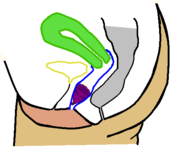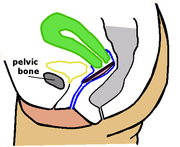Menstrual cup: Difference between revisions
No edit summary |
m →Official company websites: Removed redundant link |
||
| Line 135: | Line 135: | ||
*[http://www.mooncup.co.uk/ The Mooncup] |
*[http://www.mooncup.co.uk/ The Mooncup] |
||
*[http://www.lunette.fi/en Lunette] |
*[http://www.lunette.fi/en Lunette] |
||
*[http://www.lunapads.com/ |
*[http://www.lunapads.com/ LunaPads] |
||
*[http://www.gladrags.com/ Sea Sponge Tampons, Cloth Pads, and Menstrual Cups] |
|||
*[http://www.gladrags.com/-c-22.html/ GladRags] |
*[http://www.gladrags.com/-c-22.html/ GladRags] |
||
Revision as of 20:35, 17 August 2007
 |
 |
A menstrual cup is a type of cup or barrier worn inside the vagina during menstruation to collect menstrual fluid. Unlike more common methods, such as tampons and pads, the cup neither absorbs the flow nor catches it outside the body.
There are two types of menstrual cup currently available for sale in the USA, Canada and UK (or over the internet). The most common is a bell-shaped cup made of rubber (latex) or silicone. It is reusable and designed to last for up to 10 years. Current brands include The Keeper, The DivaCup, Lunette and The Mooncup. The second type is currently only manufactured by one company and is called Instead. It resembles the contraceptive diaphragm (although it is not a contraceptive device ).
Menstrual cups are not widely used at present. The majority of women in Western countries use disposable tampons or disposable sanitary napkins (also known as towels or pads). A number of different companies have attempted to promote the use of menstrual cups during the 20th century; many of these products were withdrawn when they failed to gain enough market share. This may change with the potential growth of the alternative sanitary product market. Other popular alternatives to traditional products include: non-bleached (and often non-GM cotton) or organic tampons; washable cloth sanitary napkins; and natural sponges.
Usage

Menstrual cups are worn inside the vagina and a cup can be used at any time during the menstrual cycle. Users of bell-shaped cups can usually choose from two sizes to fit their body shape. The disposable cup is prepared by flattening the rim against itself, but reusable cups are more flexible and a variety of forms (referred to among users by names such as "punch-down fold" and "7-fold") exist. The user may apply lubricant to ease insertion, though the presence of menstrual fluid in the vagina is usually sufficient. The disposable type of cup is inserted into the vagina and pushed into place near the cervix and behind the pubic bone, where the internal structure of the body keep it in place. The bell-shaped cup is inserted until the body of the cup and stem are completely inside, then held by the lower point or stem and turned; this opens the cup and creates a seal between the rim and the inner vaginal walls. The reusable cup will situate itself and need not be placed as high as the cervix nor tucked into a specific spot, as long as it is completely open.
Removal should occur as needed, but the cup should never be left in longer than the manufacturer recommends (usually 12 hours). Menstrual cups require relatively less attention and maintenance by the user than more traditional menstrual hygiene methods. The reusable cups are designed to hold roughly 30 mL (1 ounce) of fluid, which is a third of the entire volume of blood lost in an average menstrual period. Bearing down with the muscles will help bring the cup within reach. The Instead design can be pulled out by a fingertip hooked into the rim. The lower part of the bell-shaped cup usually features "grips" or slightly raised ridges as well as a stem to assist removal. A disposable cup should be discarded and replaced, but the reusable cups need only be emptied, cleaned (preferably with hot water and gentle soap or with a paper towel when this is not possible), and reinserted.
At the end of menstruation, the reusable cup should be well-cleaned and carefully stored. Since silicone versions can tolerate high temperatures, very hot water is a popular option: a few minutes of stovetop boiling or even a run through the dishwasher provide sufficient sterilization. However, hand-washing in mild soap and hot water is the only absolute necessity. After drying, the cup must be placed in storage that allows for air flow; for example, the DivaCup and the "Keeper" each comes with its own drawstring cotton bag. When menstruation begins again, the cup should be inspected for any damage, then washed in warm water just before being used. Some discoloration can set in over time, though this does not affect the cup's performance. Proper care will prolong the life of the cup, allowing several years of use.
</gallery>Small Text
| Opened bell shaped cup | Diaphragm-style cup | Non-expanded tampon |

|

|
 |
| The bell-shaped cup is worn low in the vagina. It may work its way higher during the day, which is perfectly natural, but it is not designed to be placed over the cervix. Every bell-shaped cup has a tab at the bottom to make it easier to remove. | Instead is inserted and worn in the same way as a contraceptive diaphragm. It sits over the cervix, and is kept in position by pressure from the pubic bone. To remove, hook a finger over the rim and pull it down past the pubic bone. | A tampon should be inserted up next to the cervix; this is the most comfortable position as it leaves plenty of room for the tampon to expand both widthwise and lengthwise as it absorbs the flow. A tampon has a string stitched through it which hangs clear of the
body for ease of removal. |
Safety
With proper care, all kinds of menstrual cups are sanitary and statistically safer to use than tampons[citation needed]. They are regulated by the Food and Drug Administration (FDA) in the United States, and have been used for decades. No reported cases of toxic shock syndrome have been attributed to the use of menstrual cups, nor have any other health risks.
Comparisons with tampons and sanitary napkins
Many advantages/disadvantages are a result of personal preference. However, some of the more commonly mentioned ones are listed below.
General
Advantages
- Can be worn up to twelve hours before emptying. Manufacturers recommend that tampons and pads be worn for no more than eight hours.
- Contain no harmful substances (e.g. dioxin and bleach), unlike many commercial tampons and sanitary napkins.
- Compared to sanitary napkins
- Compared to tampons
- Do not dry/scratch the vaginal walls or leave fibers behind.
- Do not interfere with the vagina's natural sloughing off of dead cells.
- Have never been linked to Toxic Shock Syndrome (TSS).
- Can be inserted at any time of the month. This allows the user to practice inserting the cup or to insert the cup when they are expecting their period, instead of having to wait for it to begin.
- After urination, leaves no wet string behind.
Disadvantages
- Some are uncomfortable with inserting the cups, or with wearing them internally.
- Removal and/or insertion may take some practice, and can be messy if an inappropriate technique is used.
- Requires access to soap and running water, or hand wipes, for cleaning hands before and after removal and insertion.
Bell-shaped cups
Advantages
- Minimal waste
- Does not dry out or tear the mucus membranes of the vagina.
- The only thing to dispose of is the menstrual blood.
- Ideal for situations such as hiking or camping when disposal of menstrual products would otherwise be a burden.
- Reusable design does not contribute to landfills or other waste collections.
- Very little packaging required, as compared to tampons or sanitary napkins.
- Longer-lasting
- Useful for travel, where access to tampons or sanitary napkins could be limited.
- Cost less than tampons or sanitary napkins, if expenses are added up over the long-term.
- Some manufacturers, such as The Keeper and The DivaCup, offer a money back guarantee.
- Manufacturing may be less harmful to the environment, as it does not use bleach, wood pulp, or other potentially environmentally damaging substances.
- Require very little storage room, making them ideal for packing in luggage or for those who have very limited living space.
- Allow the user to track the amount of menstrua by visually inspecting the contents of the cup.
- Can be used for a wider range of anatomical structures (ex. with tilted uterus) because it sits lower in the vagina.
Disadvantages
- Weak vaginal muscles may allow the cup to slip too low.
- Changes in cup position and subsequent leakage may be caused by an orgasm, a full bladder or rectum, and by defecating.
- Incorrect insertion may also cause leakage. Correct insertion technique typically requires practice.
- Require a greater initial investment than either tampons or sanitary napkins.
- Require some care and upkeep, while disposable devices may simply be thrown away.
Diaphragm-style cups
Advantages
- Can be worn during sexual intercourse, though menstrual cups are not a contraceptive device.
Disadvantages
- Create more non-biodegradable waste than either tampons or sanitary napkins. (Although not designed for repeated use, they are typically sturdy enough to be washed and reused for an entire cycle.)
- One-time use creates waste, which is an environmental concern, especially as the materials used are non-biodegradable.
- Can be expensive.
- Need to be disposed of in an appropriate waste receptacle.
- Should not be worn by those with IUDs.
See also
- menstrual cycle, endometrium
- Kegel exercises
- tampons, sanitary napkins (UK: towels), sponge
- hygiene, toxic shock syndrome, candidiasis, cystitis, E. coli
- pollution, environmental movement, ecology movement
External links
- The History of Menstrual Cups from the Museum of Menstruation and Women's Health - including many photographs of menstrual cups available today, and those from earlier in the 20th century, and comments from those who have worn them
- Tampaction - the Tampaction campaign of the Student Environmental Action Coalition
- Go Ask Alice! - The Ins and Outs of Menstrual Cups
- Menstruation Products: A Compare-And-Contrast - explaining how to use tampons, pads, and menstrual cups
- A wiki FAQ page about menstrual cups
- Livejournal menstrual_cups community
- MoonKeeperDivas Yahoo! group
- Instructions on several ways to fold a menstrual cup before insertion, with pictures
Tampons and menstrual cup comparison pictures
